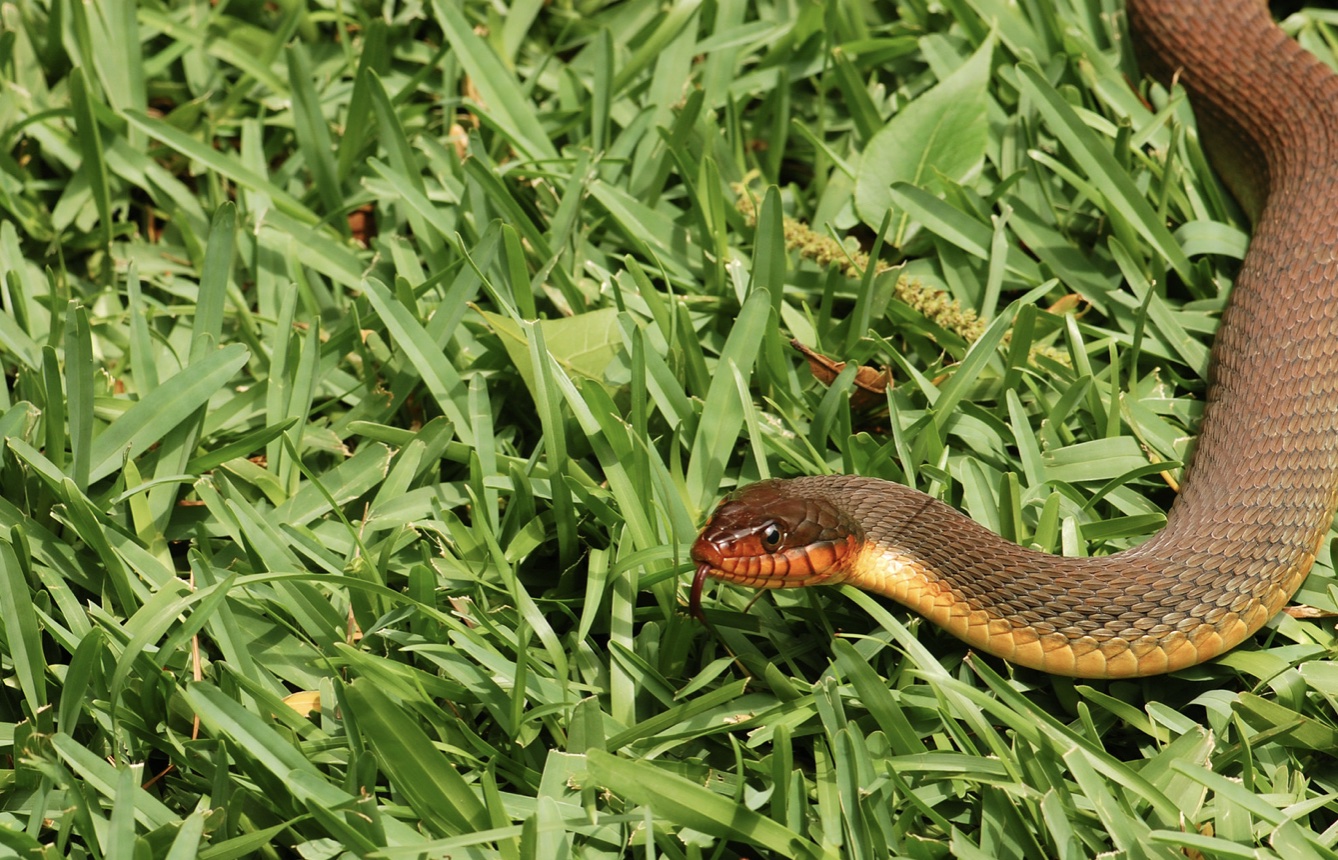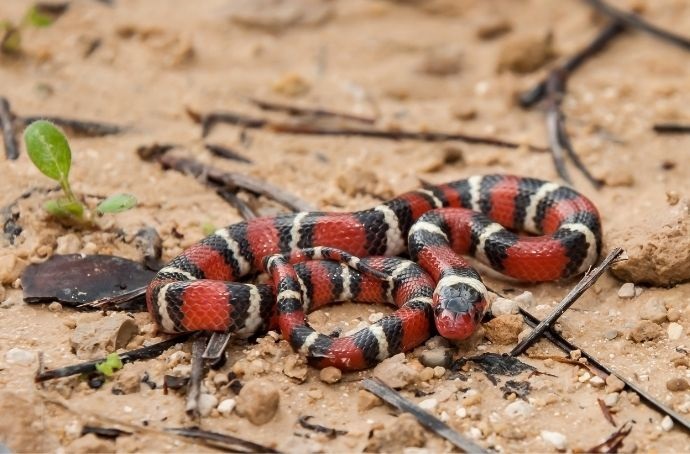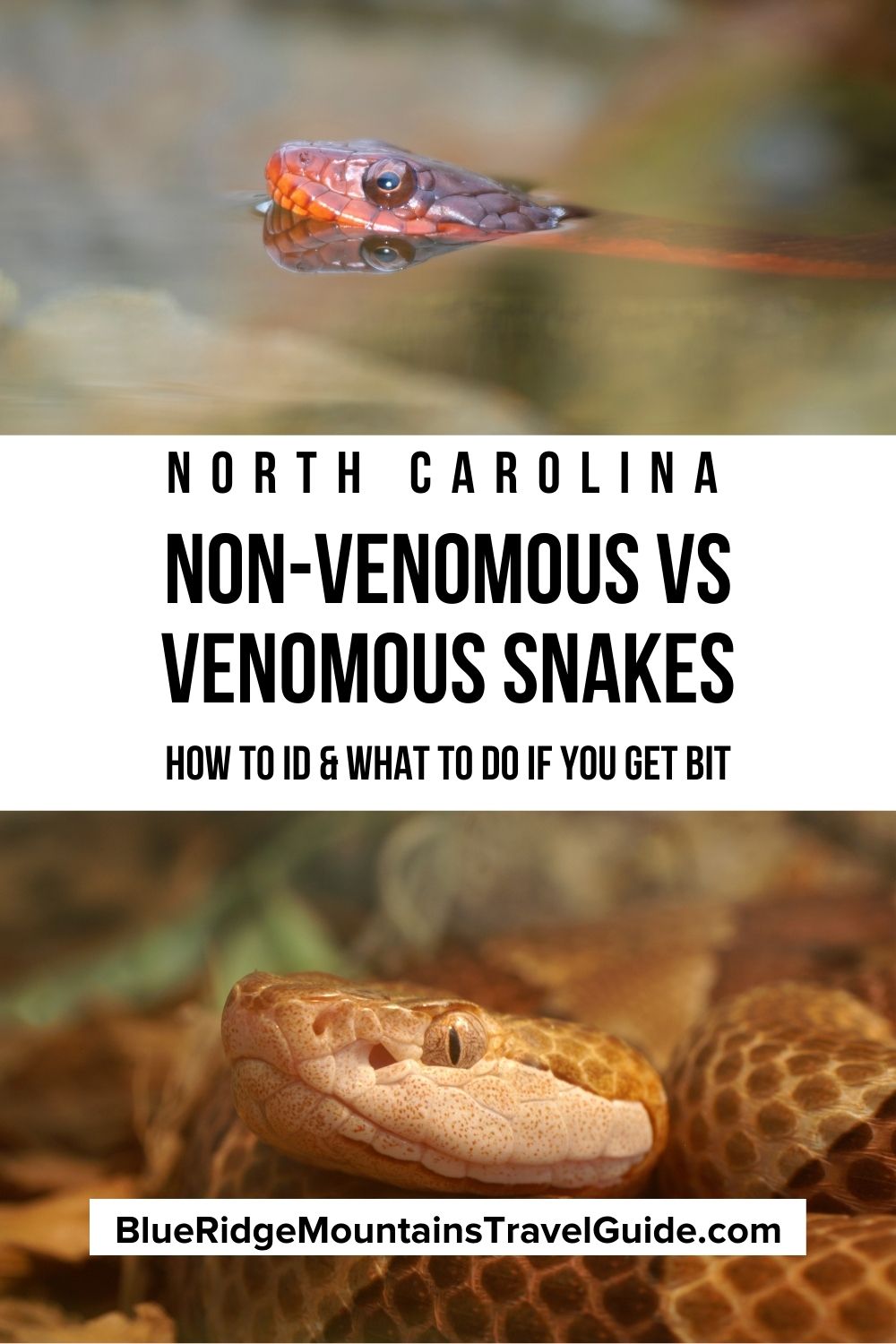[Updated February 20, 2023] When it comes to snakes in North Carolina, some people have a deep, abiding fear that no amount of practical knowledge can subdue.
In their eyes, a snake is a snake, and any snake is dangerous. Unfortunately, this results in a dead snake much more frequently than a bitten person.
Some camping and hiking enthusiasts innately tap into their inner Steve Irwin, and can’t seem to fight the urge to run towards snakes.
Unfortunately, this often results in an irritable snake, which is likely the last thing any animal lover would want.
My wife, Emma, grew up in Britain. She was never exposed to dangerous snakes, so she never acquired a healthy fear of them. She often moves closer to venomous snakes and non venomous snakes in equal measure, with her camera at the ready.
Being from Louisiana, I tend to err on the side of caution. I grew up near a pond that was thick with water moccasins and anecdotes (no doubt false or exaggerated) of water skiers falling into nests of angry snakes.
Despite being interested in the snakes common to North Carolina, the fear-first instinct is deeply instilled in me. Nevertheless, we’re both fans of snakes, which causes bewilderment among friends and family.
After moving to North Carolina a few years ago, we couldn’t wait to begin spotting the native North Carolina snakes around our homestead and in the forests of the Blue Ridge Mountains.
Read on for our guide to venomous snakes and non venomous snakes in North Carolina, including tips on identification of the most common species.
READ MORE: Non-Venomous vs Venomous Snakes In Georgia (Identification Guide)
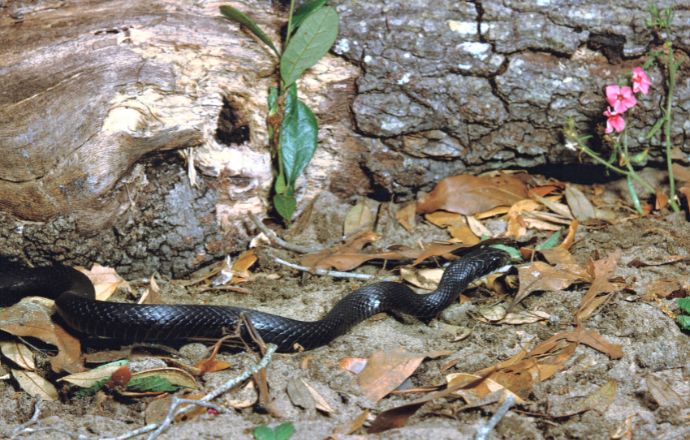
Non-Venomous vs Venomous Snakes in North Carolina Guide
- Canebrake/Timber Rattlesnake (Crotalus horridus)
- Copperhead (Agkistrodon contortrix)
- Cottonmouth/Water Moccasin (Agkistrodon piscivorus)
- Eastern Coral Snakes (Micrurus fulvius)
- Eastern Diamondback Rattlesnake (Crotalus adamanteus)
- Pygmy Rattlesnake (Sistrurus miliarius)
- Brown snake (Storeria dekayi)
- Corn snake (Pantherophis guttatus)
- Eastern Garter Snake (Thamnophis sirtalis)
- Eastern Hognose Snake (Heterodon platirhinos)
- Eastern Milksnake (Lampropeltis triangulum triangulum)
- Eastern Racer (Coluber constrictor)
- Eastern Rat Snake (Pantherophis obsoletus)
- Northern Water Snake (Nerodia sipedon)
- Red-bellied Snake (Storeria accipitomaculata)
- Rough Green Snake (Opheodrys aestivus)
- Scarlet Kingsnake (Lampropeltis elapsoides)
- Worm Snake (Carphophis amoenus)
READ MORE: The 10 Best Things to Do in Winston Salem NC
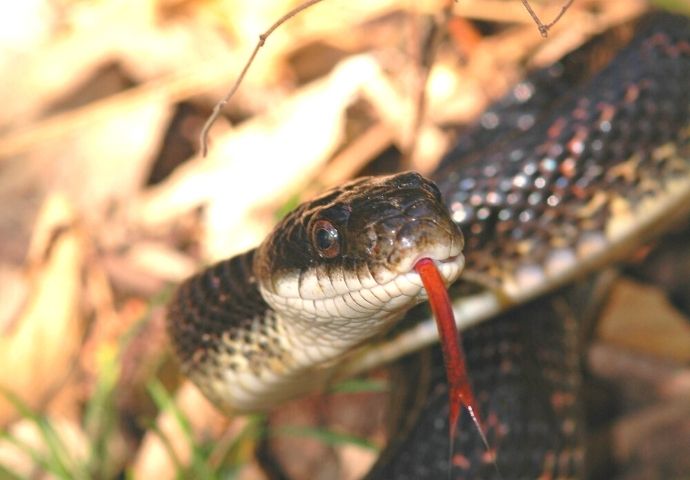
Identifying Snakes in North Carolina: Non-Venomous vs Venomous
In general, the few venomous snakes in NC have bulkier bodies, triangular heads, and cat-like eyes.
While there are exceptions, there are other helpful hints when you’re trying to determine whether or not a snake is actually dangerous.
It begins with having a realistic perspective. There are 37 species of snakes in North Carolina, with 31 types of non-venomous snakes in NC and only 6 types of venomous snakes.
Of those 6 “poisonous” snakes in North Carolina, three of them are relegated to the hotter, far southeastern section of the state. They aren’t found anywhere else!
In other words, the likelihood of crossing paths with one of NC’s “poisonous” snakes is far lower than seeing one of the many non-venomous snakes.
Furthermore, we only need to know how to ID a few NC snakes in order to know whether a snake is of any concern with regards to our personal safety.
READ MORE: The 15 Best Treehouse Rentals in the North Carolina Mountains
Commonly Confused Venomous and Non-Venomous Snakes of NC
That being said, there are a few mistaken identities to be aware of in NC snake identification. Some of the non-venomous species can be misidentified because they look similar to venomous snakes.
Scarlet kingsnakes and Eastern coral snakes can be confused, as both have bands of yellow, red, and black.
Firstly, scarlet kingsnakes are found throughout North Carolina, but coral snakes are rare in a few southeastern counties. But, the ordering of these bands is the easiest tell-tale sign between them.
The kingsnake has red and black bands next to each other, while the venomous coral snake has red and yellow bands as neighbors. Remember, “Red and black, friend of Jack; red and yellow, kill a fellow.”
Pygmy rattlesnakes and North Carolina’s non-venomous hognose snakes (two species) have similar appearances as well.
They all have gray-black patterns, short and stocky bodies, and striking heads/noses. However, pygmy rattlesnakes have cat-like eyes as well as a rattle that sounds like a small insect, and inhabit the far south and far east regions of the state..
It’s common for people to call all water snakes water moccasins (a.k.a. cottonmouths). However, there are far more non-venomous North Carolina water snakes found near rivers and waterfalls, some of which are often mistaken for water moccasins.
Banded water snakes, brown water snakes, and northern water snakes all look similar to cottonmouths, and they behave similarly when threatened: flattening their bodies, emitting a smelly musk, and striking.
In other words, it’s best just to give a wide berth of any of these snakes when you’re in the water moccasin’s native habitat in NC.
READ MORE: The Best Hiking in Asheville NC Bucket List (Top 20 Hiking Trails)
Venomous Snakes in North Carolina
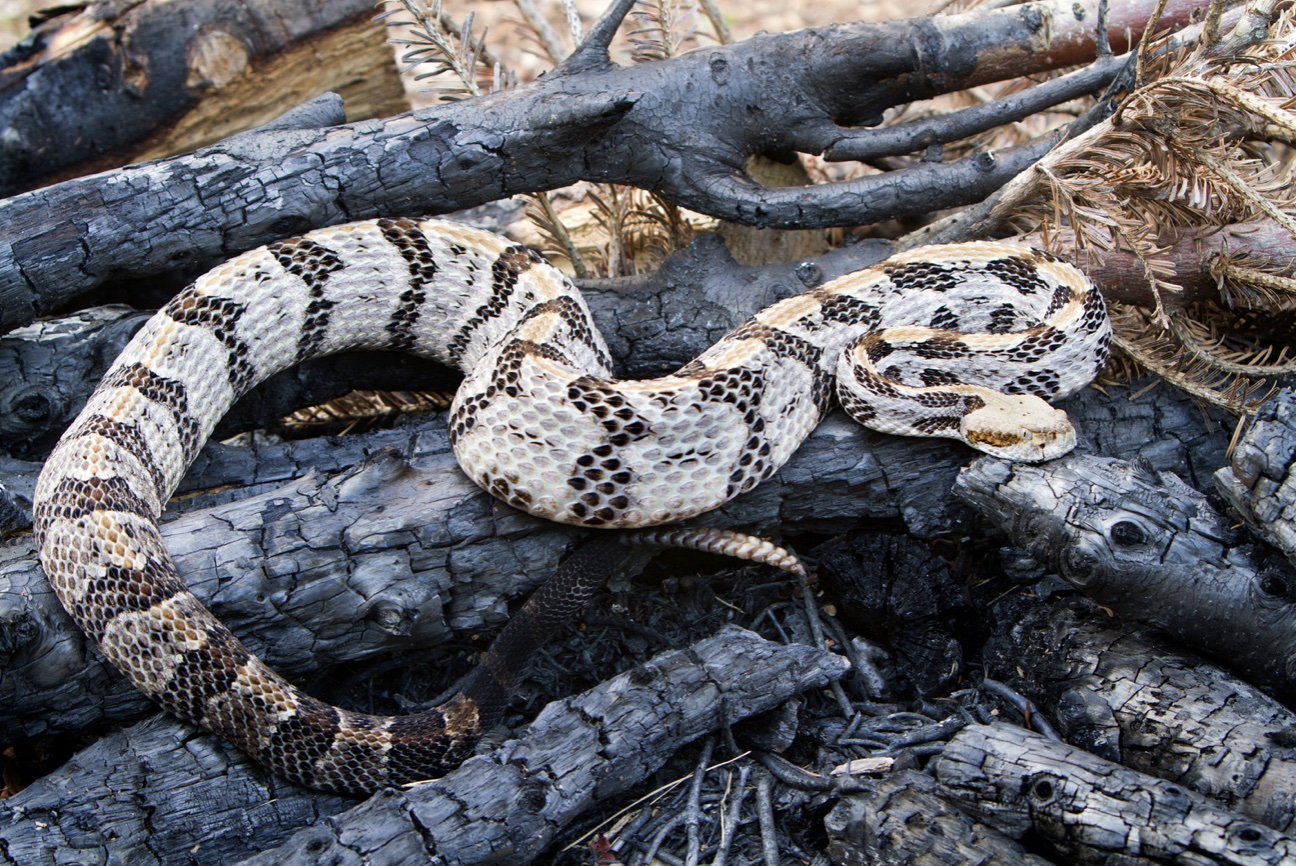
1. Canebrake/Timber Rattlesnake
Crotalus horridus
One of two venomous snakes that are native to Western North Carolina, timber rattlesnakes (which are called canebrake in lower elevations) are found throughout the Eastern United States.
They can grow up to 6.5 feet long, with black crossbands (or chevrons) on a lighter gray to orange-brown background.
In North Carolina, they’re found in the Blue Ridge Mountains, southern counties, and along the east coast. They live everywhere from the NC High Country near Boone and Blowing Rock to the coastal plains.
Like many larger snakes, timber rattlers primarily feed on rodents, helping to control these populations.
They mate in the late summer/early fall, which is when they are most likely to be encountered.
READ MORE: Fall in North Carolina: 20 Great Places to See Fall Colors in Western NC

2. Copperhead
Agkistrodon contortrix
The other of the two venomous snakes in Western North Carolina, copperheads are the most common venomous snake in the state.
In short, there are copperheads in all North Carolina counties..
Copperheads can grow up to four-plus feet. They have beautiful markings, with dark brown hourglass crossbands on a lighter tan background. And, of course, they have distinctive copper-colored heads.
These snakes like to ambush their prey, including mice, frogs, and insects.
Copperhead snakes in North Carolina prefer to stay in the forest, and are known to hibernate with timber rattlesnakes in the mountains.
READ MORE: The 20 Best Pisgah National Forest Hiking Trails in North Carolina
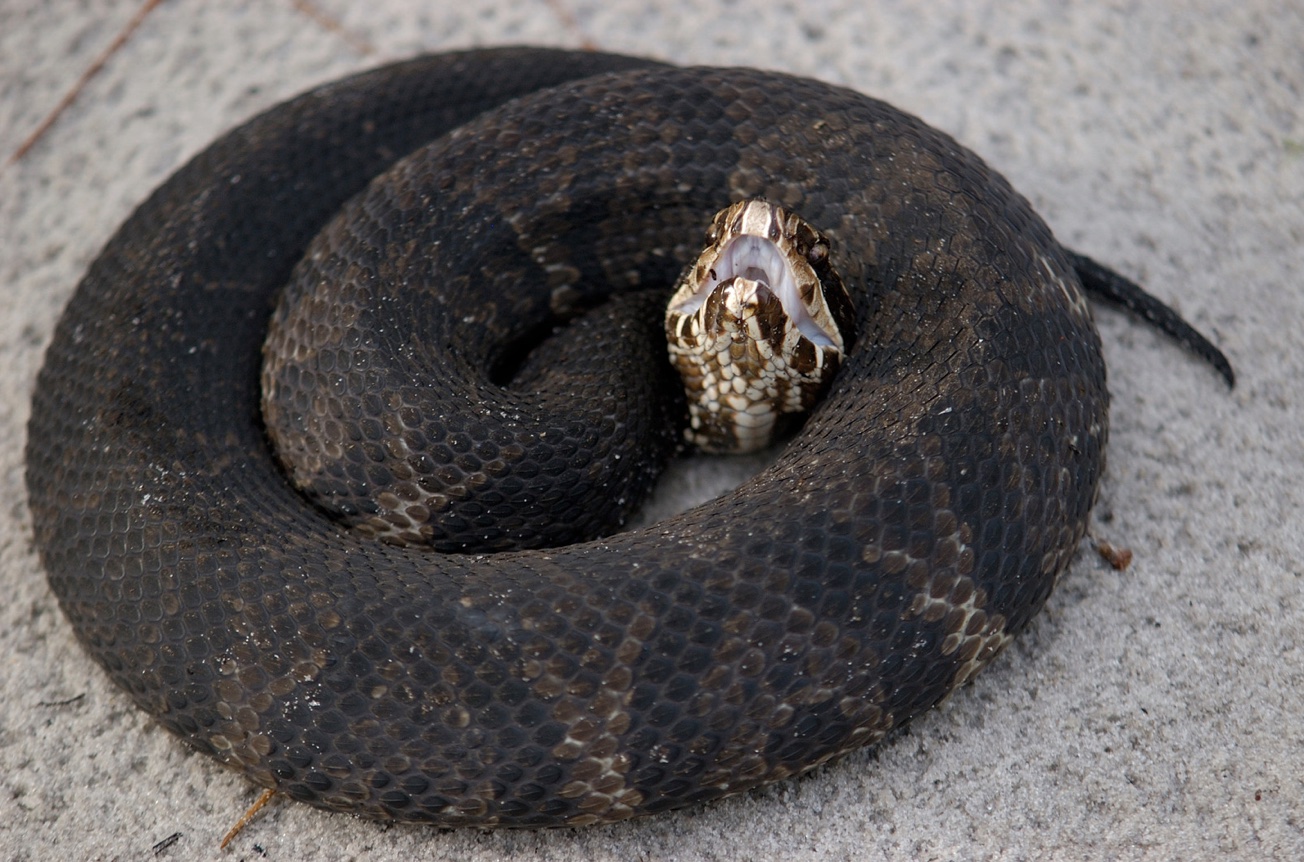
3. Cottonmouth/Water Moccasin
Agkistrodon piscivorus
One of the most notorious snakes in the Southeastern US, the cottonmouth/water moccasin is a semi-aquatic snake that usually lives near water. But it can be found elsewhere.
In North Carolina, water moccasins only live in the eastern counties. Remember, there are no venomous water snakes in Western NC whatsoever.
Growing up to 6 feet long, cottonmouths are dark, heavy-bodied snakes with black bands. Adult snakes are often darker than the younger ones.
They have white coloring inside their mouths, which they open wide when threatened. They also flatten their bodies to look larger, and exude an unpleasant odor.
These snakes have a wide-ranging diet, including rodents as well as frogs, fish, and other snakes.
READ MORE: The 10 Best Lakes in the North Carolina Mountains to Visit
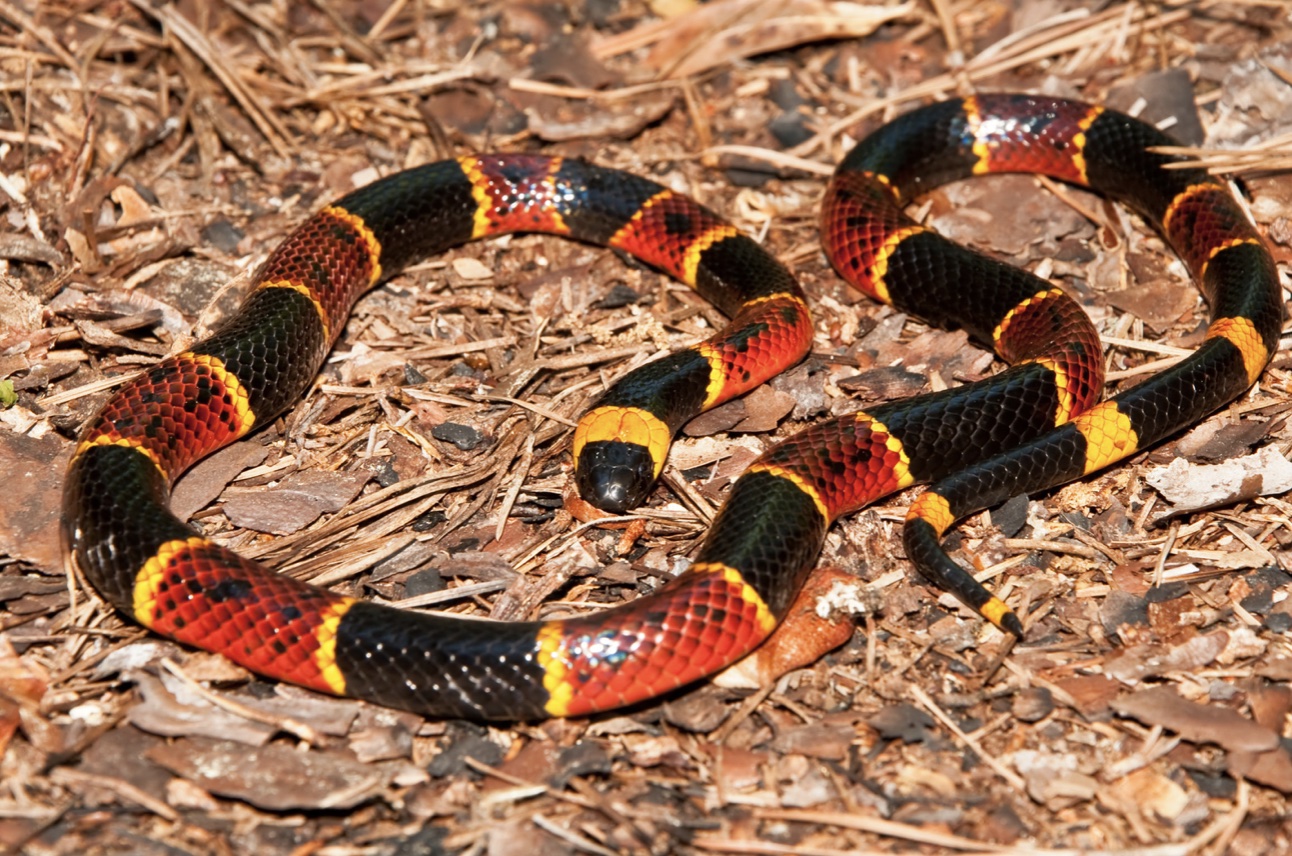
4. Eastern Coral Snakes
Micrurus fulvius
Eastern coral snakes like warmer environs and generally stick to the southeastern region of North Carolina. Even there, they are extremely rare.
These snakes are in the Elapidae family, the same as cobras and mambas. They have fixed fangs rather than the retractable fangs that are associated with rattlesnakes and vipers.
Unlike most venomous snakes, coral snakes tend to be thin. They have red, yellow, and black bands, with thin yellow bands separating the thicker red and black bands.
The Eastern coral snake feeds on smaller snakes and lizards. They spend most of their time underground and are extremely shy, so they’re much more apt to run than bite.
It should go without saying , but never try to pick them up. When they do bite, they don’t let go, and they have very powerful venom that attacks the central nervous system.
READ MORE: The 10 Best Campgrounds in the North Carolina Mountains
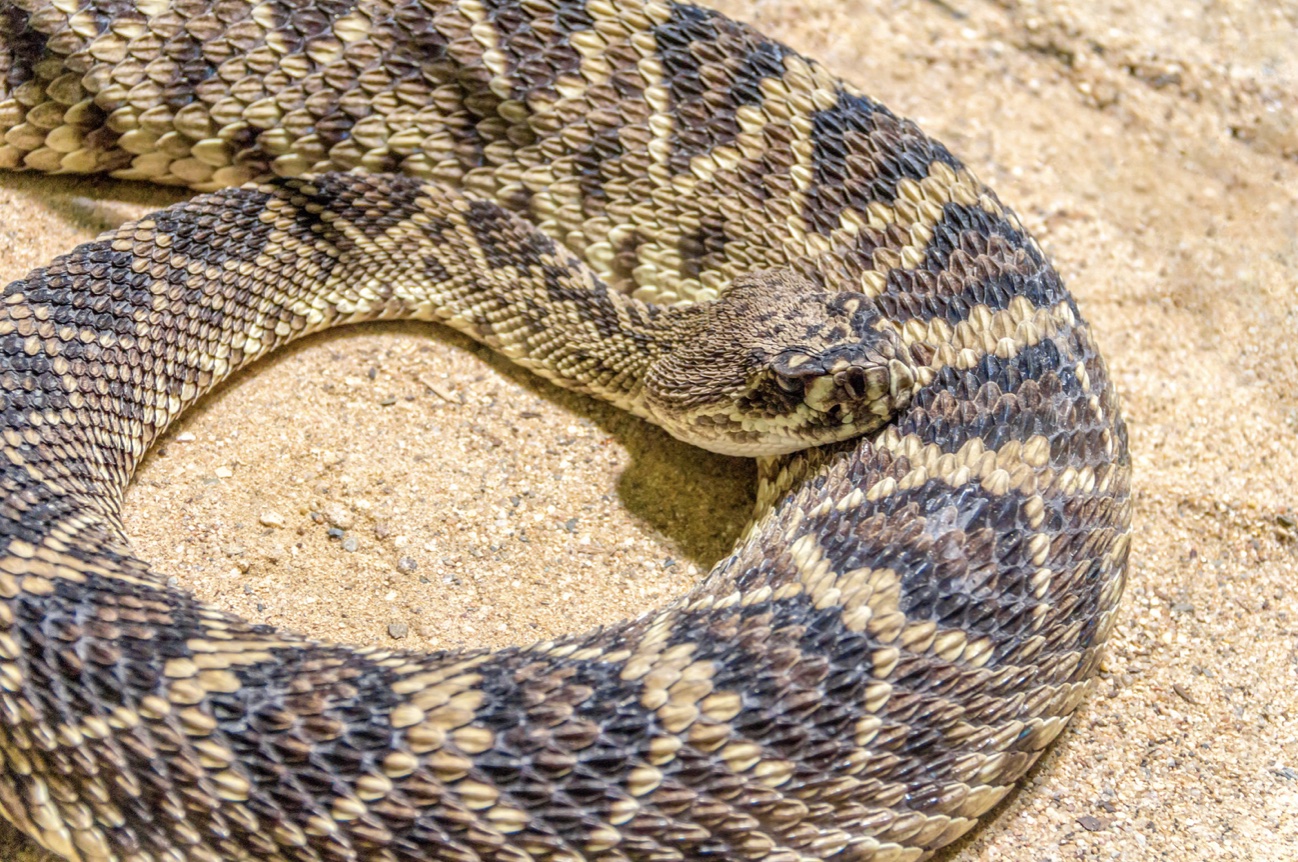
5. Eastern Diamondback Rattlesnake
Crotalus adamanteus
One of four North Carolina rattlesnakes, the Eastern diamond rattlesnake is the largest of the lot. It can reach up to eight feet long!
This venomous snake is only found in the Coastal Plains in the far southeast reaches of the state. Even there, its numbers are very low due to habitat destruction.
Eastern diamondbacks have yellow-ish, gray backs with dark bands that form diamond outlines, which camouflages them very well. But when frightened, they will rattle an alarm.
Like the other large, venomous snakes in North Carolina, Eastern diamondback rattlesnakes help to control the rodent population.
READ MORE: The 20 Best Blue Ridge Parkway Hikes for NC Day Trips
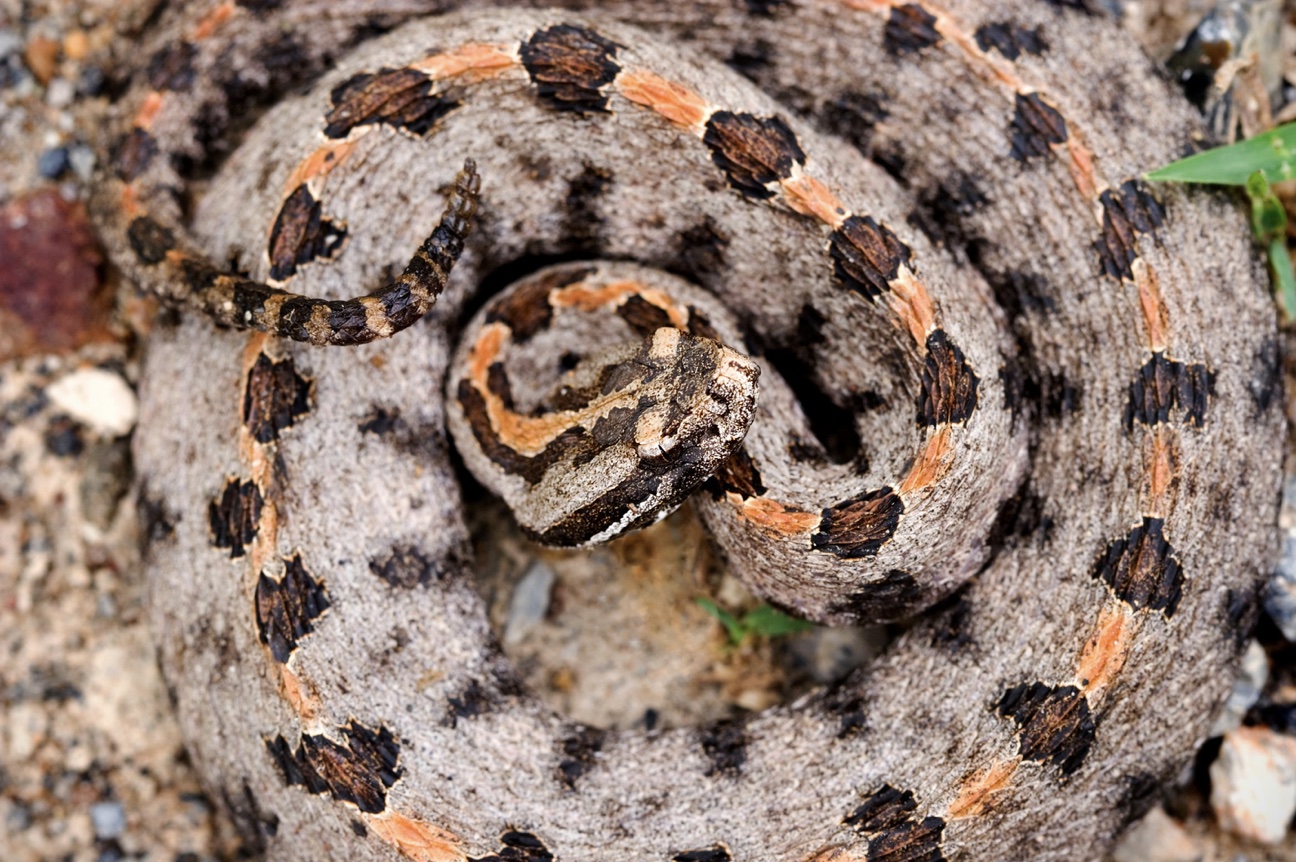
6. Pygmy Rattlesnake
Sistrurus miliarius
Recognized as the smallest rattlesnake in the United States, the appropriately named pygmy rattlesnake is less than 3 feet long. This snake is so small, its rattle buzzes like an insect!
Pygmy rattlers are mostly found in the southeastern counties of NC, with a few sightings reported in Crowder’s Mountain State Park in Gaston County (near Charlotte).
This attractive NC rattlesnake feeds on small prey, such as frogs, lizards, and mice.
The Pygmy rattlesnake will bite if cornered, and we’re fairly certain that would not be fun. But thanks to its diminutive size, its venom is considerably less potent than that of other rattlesnakes in North Carolina.
READ MORE: The 21 Best Blue Ridge Parkway Waterfalls in North Carolina
Common Non-Venomous Snakes in North Carolina

7. Brown snake
Storeria dekayi
Brown snakes in North Carolina are small, usually under a foot but capable of getting nearly two feet.
NC brown snakes are typically light brown, but can lean towards gray or ruddy brown. Their undersides are white. with black dots along the edges.
Brown snakes like to live in gardens, feeding on pests such as snails and slugs, as well as earthworms. They also like to hide under logs and rocks, as well as piles of trash in vacant lots.
These snakes are very common to North Carolina and are found in every county of the state.
READ MORE: The 30 Best Things to Do in Asheville NC
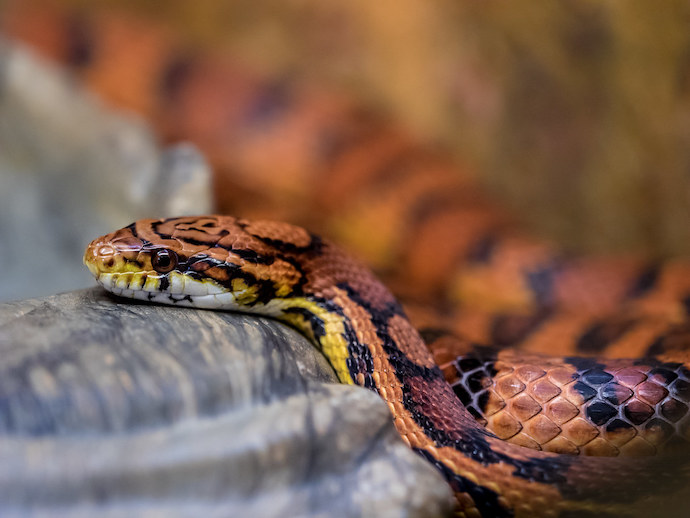
8. Corn snake
Pantherophis guttatus
Corn snakes earned their names by hanging out in corn cribs, grain bins, and barns, where rats and mice— their favorite prey– tend to visit.
These snakes are constrictors that squeeze their prey to death before swallowing it whole.
Capable of growing up to 6 feet long, corn snakes are beautiful, with red blocks bordered in black on an orange-brown background. In the coastal plains, North Carolina corn snakes tend to have brighter colors.
They live everywhere in the state except for the far northern counties along the Virginia border.
They are usually found at the edges of fields, often hiding under logs, old boards, or tin.
READ MORE: The 20 Best Pumpkin Patches in the NC Mountains
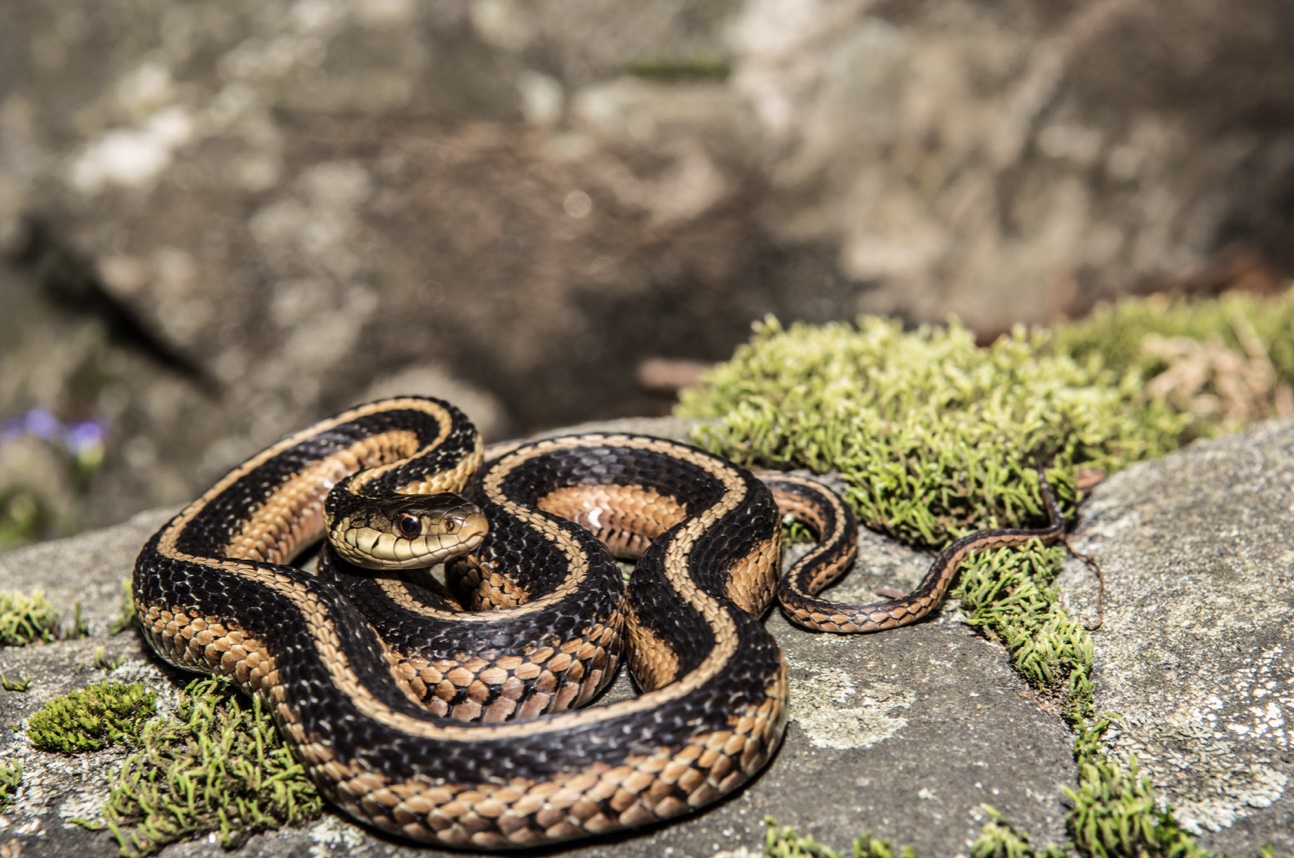
9. Eastern Garter Snake
Thamnophis sirtalis
One of the most prolific snakes in the United States, eastern garter snakes can be found just about anywhere in the country.
They are present throughout the state of North Carolina, and particularly love being near water.
They usually have dark patterns on their back, with yellow or white stripes stretching down their sides and a green-to-yellow belly. They can get as large as 4 feet, but are generally about half that long.
Eastern garter snakes prefer to dine on frogs and lizards, can swim surprisingly well, and are primarily active during the day.
The eastern ribbon snake, which is similar both in behavior and appearance, isn’t quite as omnipresent, but can also be found in NC.
READ MORE: The 20 Best Western North Carolina Waterfalls for Hiking
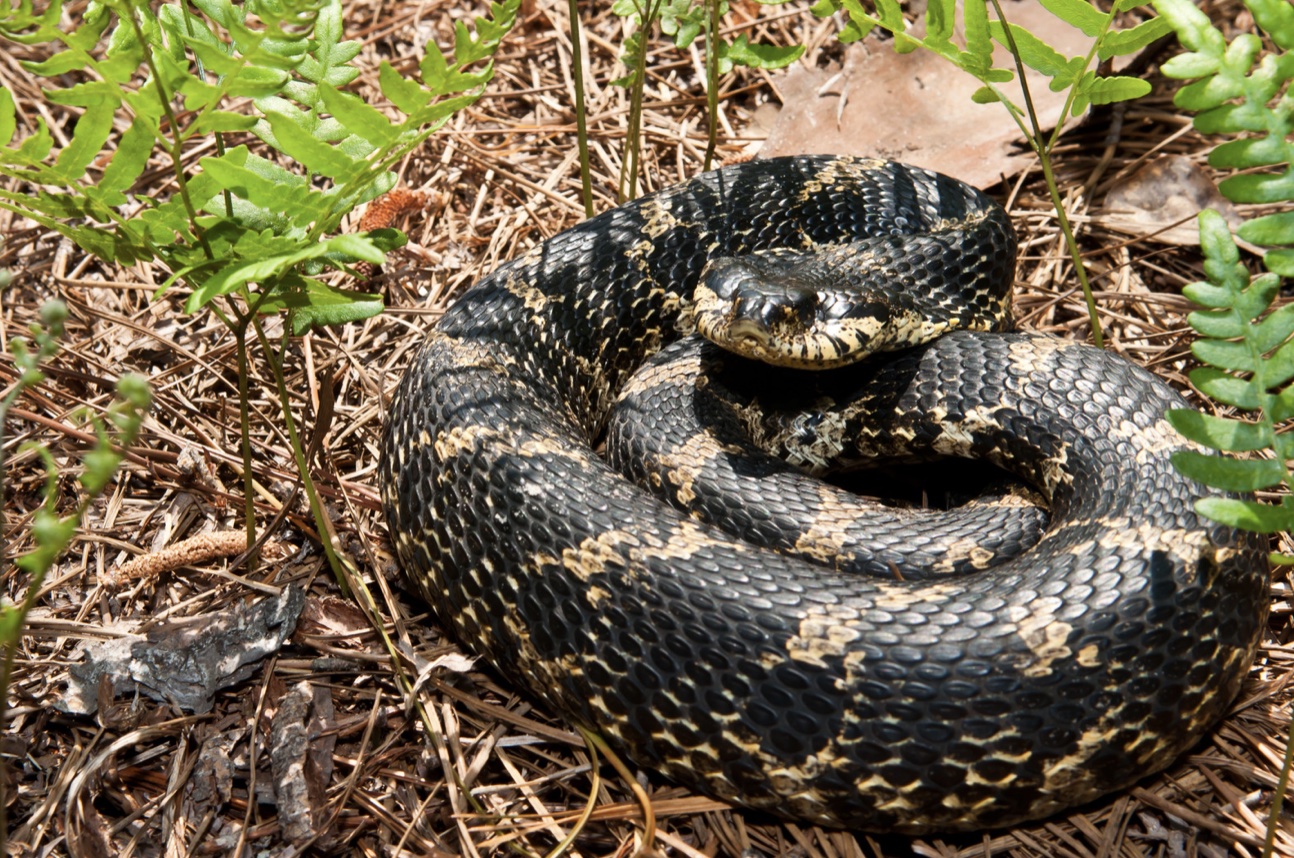
10. Eastern Hognose Snake
Heterodon platirhinos
While southern hognose snakes only occupy a small portion of the southeast region of North Carolina, eastern hognose snakes can be found everywhere.
They average a little over two feet long, and they tend to be very stocky.
They feed primarily on frogs and toads, using large teeth at the back of their mouths to pop the amphibians before swallowing them.
Hognose snakes exhibit some weird animal behaviors. They often act like cobras when initially threatened, flattening their necks and hissing at the offending party.
If they strike, they’ll often do so repeatedly. If that’s unsuccessful, they act like a possum and play dead, rolling onto their backs, opening their mouths, and writhing around with lots of drama!
READ MORE: The 15 Best Boone NC Hiking Trails to Explore
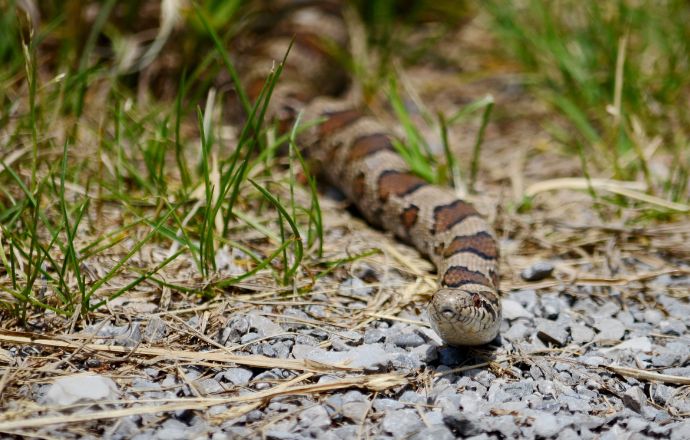
11. Eastern Milksnake
Lampropeltis triangulum triangulum
A close relative of the Scarlet Kingsnake (and sometimes confused with venomous Coral Snakes), the Eastern Milksnake is triangularly patterned rather than striped, and its browns and red colors are much more muted.
The Eastern Milksnake is also larger than its crimson cousin, sometimes measuring over 4 feet and sporting a notably thicker body.
Nevertheless, the two species are known to interbreed when occupying the same habitat, and both are constrictors that feed on small snakes, rodents, and lizards.
Eastern Milksnakes love hiding under rocks and live in fields or wooded slopes, and they are present in all regions of North Carolina.
The name “milksnake” comes from the disproved belief that these snakes have the ability to milk cows. In fact, they were commonly found on farms in barns because they were in search of mice.
READ MORE: The 15 Best Campgrounds in the North Carolina Mountains

12. Eastern Racer
Coluber constrictor
Noted for their speed, non-venomous Eastern Racers are long and slender, reaching up to six feet in length.
These common snakes are easy to confuse with Rat Snakes. But they can be distinguished by the adult Racers’ solid black coloring (Rat Snakes have whitish bellies) and smooth scales.
Eastern Racers have large eyes and can see very well, often raising their head up when hunting. They are active during the day.
Though their Latin moniker suggests Racers might be constrictors, they don’t actually squeeze their prey to death. They simply swallow it whole, feeding on small rodents, amphibians, insects, and smaller snakes.
Eastern Racers have a reputation for chasing people, but this is rarely true. If cornered, they do defend themselves aggressively with multiple bites. And most humans can outrun them without much challenge.
These snakes are at home most anywhere in North Carolina, and are often spotted in sunny spots soaking up rays.
READ MORE: The 20 Best Places to Visit in North Carolina
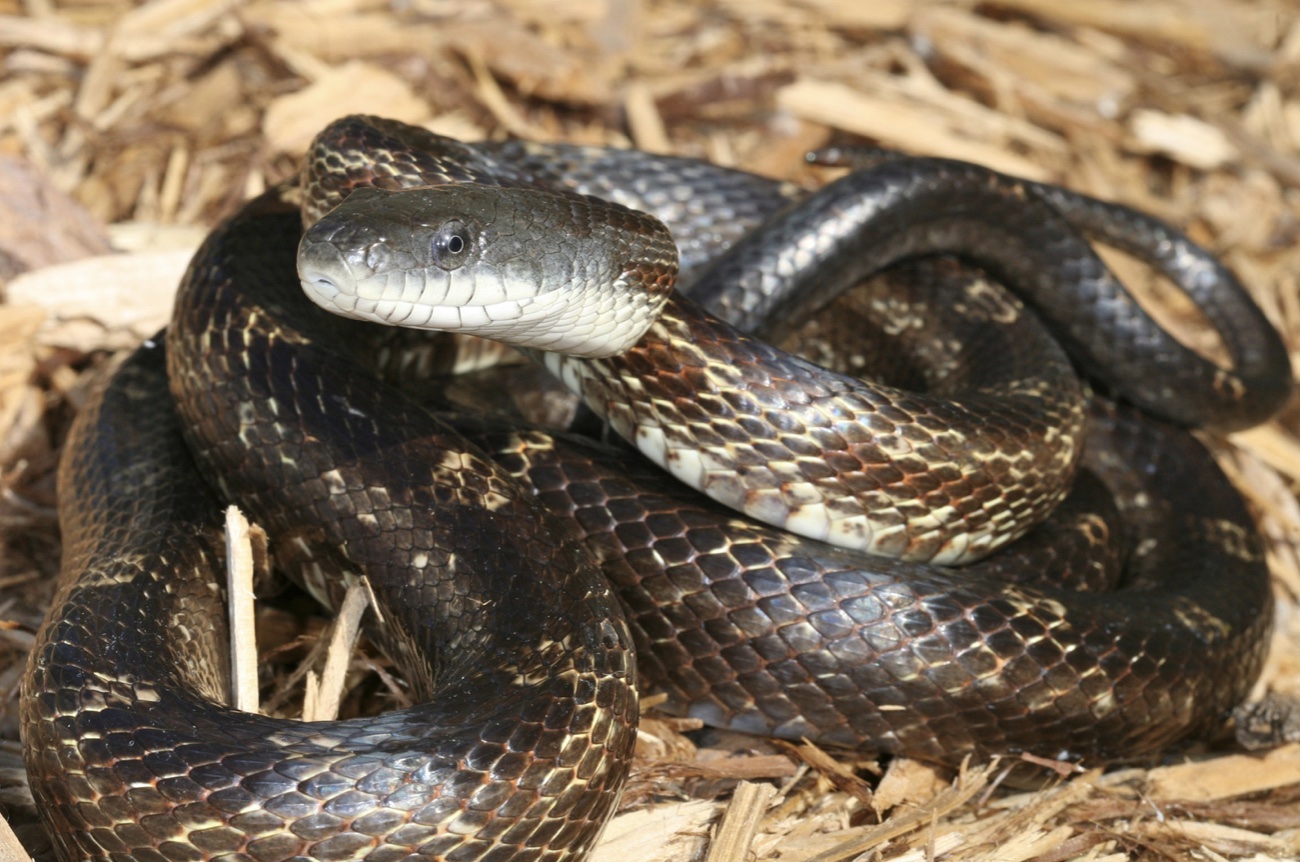
13. Eastern Rat Snake
Pantherophis obsoletus
Rat snakes can be a little startling to encounter.
They’re quite large, averaging 5 feet long and capable of growing upwards of 8 feet. They also move surprisingly quickly, despite having large bodies.
Rat snakes in North Carolina can vary in coloring.
In the mountains, they tend to be solid black with white bellies, but on the Coastal Plains they can be yellow with dark stripes and white bellies. Juveniles will have distinct, splotchy patterns.
These snakes are strong constrictors that like to eat rats and mice, as well as chicken eggs and birds of North Carolina.
They are sometimes referred to as “chicken snakes,” because they frequent chicken coops and farms.
READ MORE: Apple Picking in North Carolina: The 10 Best NC Apple Orchards to Visit
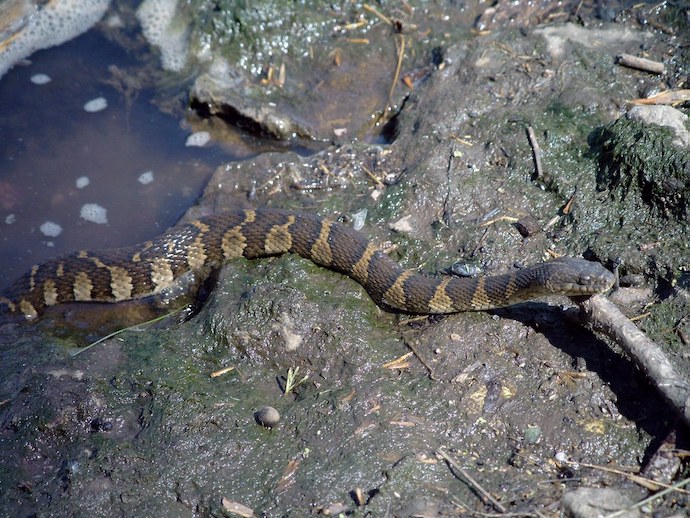
14. Northern Water Snake
Nerodia sipedon
The northern water snake is a fairly common sight near creeks and waterfalls in North Carolina, even in small towns in Western NC such as Banner Elk and Burnsville.
They can be quite large, with a heavy body that can grow up to 5 feet. They’re dark, with a variation of colors, including black, brown, gray, and red.
There are two similar non-venomous NC water snakes, the banded and brown water snakes. All three species can be confused with cottonmouths, which are dark-colored, thick-bodied. and like the water.
Northern water snakes feed on a variety of stuff, but especially amphibians and fish.
Even though the northern water snake isn’t venomous, it will bite if threatened. Much like water moccasins, it also releases a musk on attackers.
READ MORE: The 30 Best Waterfalls Near Asheville NC
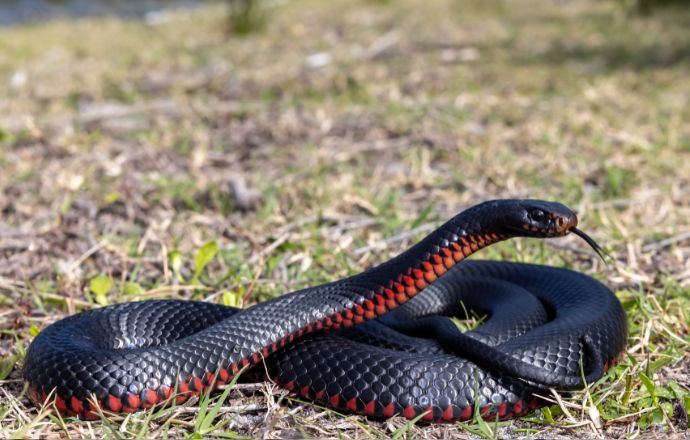
15. Red-bellied Snake
Storeria accipitomaculata
The red (or orange) belly of these snakes is a consistent characteristic, but their backs can vary from tan to rusty brown to black.
They usually have a light stripe running the length of the back, and they have three orangish spots at the neck.
A great snake to find in the garden, the main prey of the diminutive Red-bellied Snake is slugs, followed up by snails, insects, and roly-polies. They’ll also eat earthworms as well.
Red-bellied snakes are known to flatten themselves and release a musky smell when handled, and they’ve also been seen curling their upper lip when threatened.
They naturally frequent woodlands and love a moist, rotting log to nestle into. They are at home pretty much everywhere in North Carolina.
READ MORE: The 10 Best North Carolina Mountain Resorts to Visit

16. Rough Green Snake
Opheodrys aestivus
Slim and sleek as it moves through vegetation and trees, the Rough Green Snake is an accomplished climber who rarely spends time on the ground.
Though they can stretch to nearly four feet, these are small snakes that largely subsist on insects and spiders.
Rough Green Snakes blend in very well among the dense vegetation it likes to hang out in, usually around a body of water. So they’re generally difficult to spot.
We don’t encourage anyone to capture wildlife, but these snakes are known to be gentle when held and never bite.
One of the interesting facts about the Rough Green Snake is that it turns blue shortly after it dies.
READ MORE: The 15 Best Romantic Getaways in NC (Cabins, Inns & Resorts)
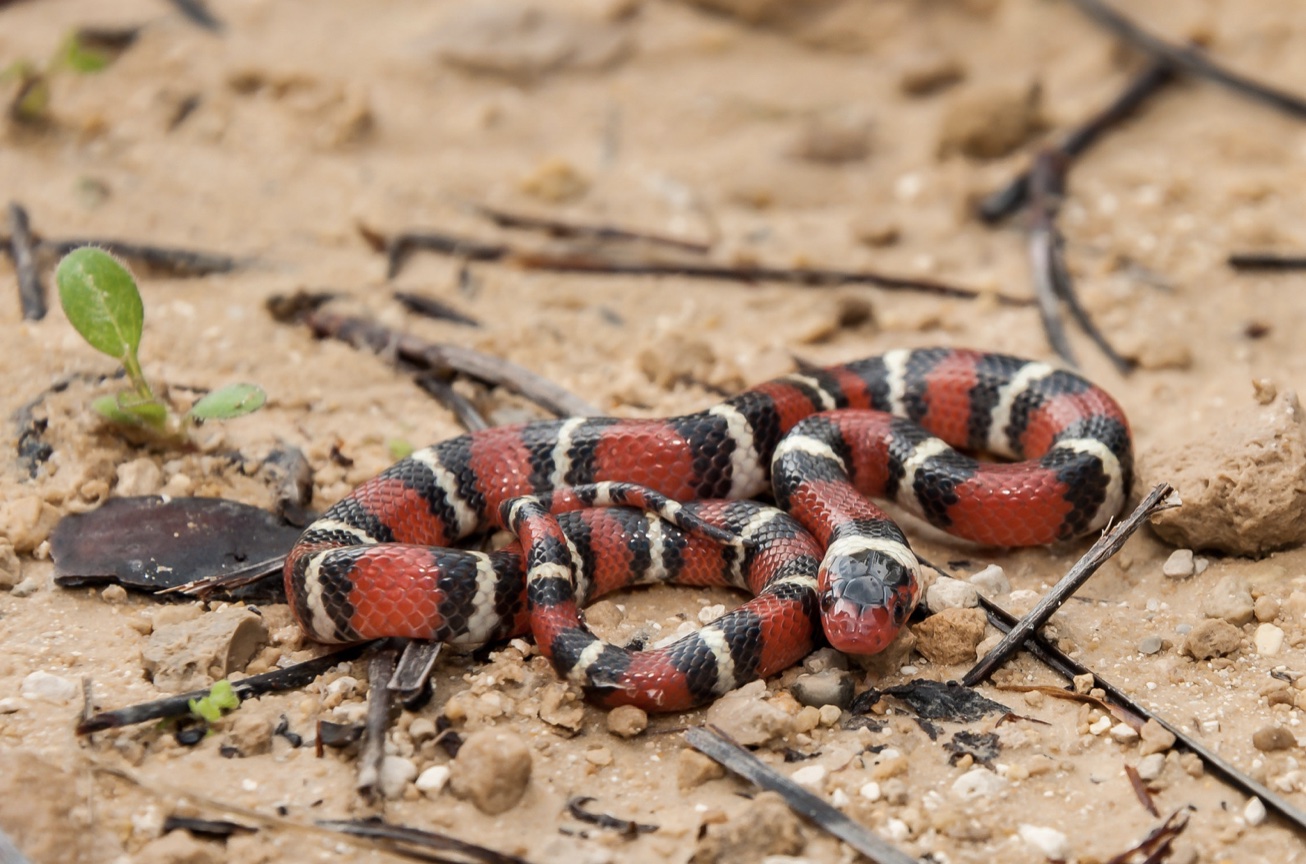
17. Scarlet Kingsnake
Lampropeltis elapsoides
The scarlet kingsnake is not the only king snake in North Carolina, but it is the most widespread species.
They like to live in the forest, where they can hide in rotting trees beneath loose bark.
Due to its vivid red, yellow, and black bands, this is widely considered one of the most beautiful native North Carolina snakes.
Those bands also make it easy to confuse with the rare and timid (but extremely venomous, coral snake.
Kingsnakes rather famously eat other, smaller snakes, as well as lizards and mice.
READ MORE: The 7 Best Hikes on the Appalachian Trail in North Carolina

18. Worm Snake
Carphophis amoenus
A small and reclusive native NC snake, Worm Snakes only average about 9 inches long, burrowing into the ground hunting insects and earthworms.
They have pointy heads and tiny eyes to aid in the pursuit of prey. Their backs are darker shades of black, gray, or brown, and their bellies are somewhere between pink and white.
They’re most active from March to October, occasionally spending warm summer nights above ground.
Aside from the soil, they can be found in rotting logs, often in a cool hardwood forest with rocky ground.
Though they swallow their prey whole, they won’t bite. They’ll wriggle in a captor’s hand, possibly pushing their spike tail into it, but without enough force to cause any damage.
Worm Snakes are found in every county of North Carolina, but you’re unlikely to spot one unless you seek them out.
READ MORE: The 15 Best Things to Do in Great Smoky Mountains National Park

What to Do If You (or Your Dog) Are Bitten by a Snake
It’s important to understand that snake bites are extremely rare, and venomous snake bites are even rarer.
In the USA, there are only around 5 fatal snake bites a year, which makes them far less likely than deaths by lightning strike (about 50 a year).
However, some 7,000 to 8,000 people are bitten by venomous snakes every year. In other words, less than 1% of those people bitten by a deadly snake each year actually die.
That being said, there are some common misconceptions about what to do if you are bitten by a snake (or if your dog is bitten by a snake) while hiking.
Using a tourniquet and sucking the venom out are actually ineffective, and ultimately more likely to cause a problem than to solve one. The same goes for taking Benadryl.
The right thing to do if you’re bitten by a snake is to remain calm, remove any jewelry that could become troublesome with swelling, and seek emergency services as soon as possible.
Another common mistake is to attempt to kill or capture the snake. The already agitated animal is likely to strike out more and cause further issues.
Instead, simply try to observe some standout physical features of the snake in order to help the professionals ID it later.
If your dog is bitten, the same rules apply. Animals do usually survive a snake bite, especially if they’re taken to a vet immediately. –Jonathon Engels

